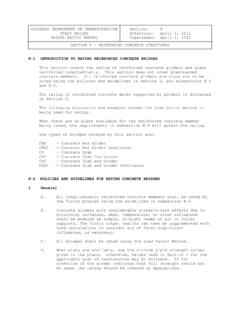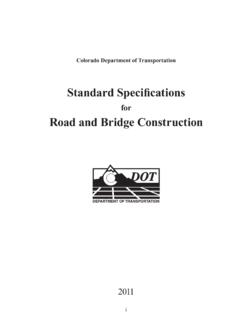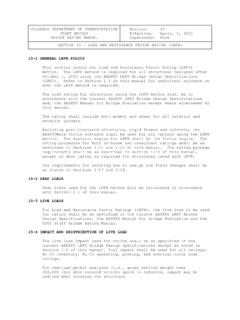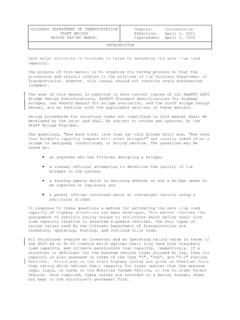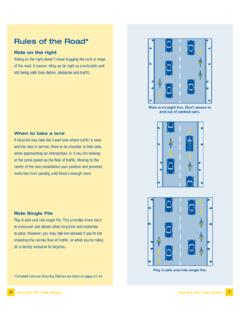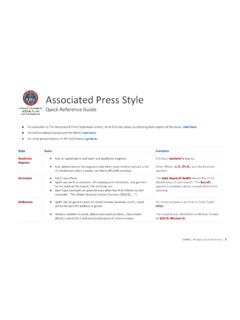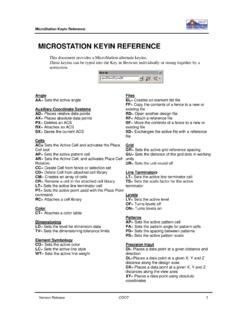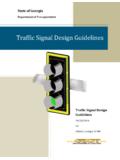Transcription of Basic Highway Plan Reading - Colorado Department of ...
1 BasicHighway PlanReadingInspectorualificationSeriesFO RWARDThis plan Reading Course is to present a step-by-step procedure on how to read, interpret, and relate to a standard set of roadway plans; to help identify and interpret symbols used in a standard set of plans; and to help develop the necessary skills to interpret a set of plans in non-technical terms to laypersons (property owners and others). Along with this manual you will use plan sheets & standards that specifically relate to it. The plan sheets/standards included have been reduced to half their original size so they can be handled more it is our intent to provide you with a well rounded exposure to Highway construction plans, you may be asked to look at a plan sheet from a particular project.
2 Please ascertain that you are looking at the correct set of plans for the text that you are Reading and the questions you may be asked to THE STUDENT This is a self-instructional study course. The subject matter is arranged so that you may work at your own speed. Each part of the course builds on the information that has preceded it, and prepares for information to follow. Most of the parts present new information. Some parts review important facts that have been introduced to you earlier in the idea behind this method is for you to read and study the information, actively participate by writing or checking off answers to questions, then find out immediately if you are correct. This method reinforces what you have read and enables you to retain what you have learned for a longer period of time.
3 The retention of information from a self-instructional study course should be far greater than from a lecture or get the most from this course, start at the beginning. Read each section as it comespreparing you for the next section. To make Reading easier, the information is divided into frames. At the end of some frames, you will find questions. By answering these questions, you will be able to retain what you have just read longer than by lecture or discussion. The answers to these questions are at the end of this document. TABLE OF CONTENTS Chapter 1: Beginning to Read PlansChapter 2: Typical SectionsChapter 3: general NotesChapter 4: Summary of Approximate Quantities & Tabulation DrawingsChapter 5: ViewsChapter 6: Stationing and Symbols Chapter 7: plan and Profile Sheets Chapter 8: Drainage and Structures Chapter 9: UtilitiesChapter 10: Signing & Pavement Markings, Signals, Highway Lighting & LandscapingChapter 11: Maintenance of Traffic, Sequence of Operations and StagingChapter 12: Stormwater Management plan (SWMP) Chapter 13: Cross SectionsChapter 14: Standards and Details Chapter 15: Right of WayCHAPTER 1: BEGINNING TO READ PLANS general INFORMATIONA requirement occurring in one of the parts of a Colorado DOT contract is as binding as though occurring in all.
4 The Standard Specifications, Supplemental Specifications, Plans, Special Provisions, and other supplementary documents are all part of the contract. In case of a discrepancy, certain parts of the contract govern over others pursuant to subsection of the Standard Specifications govern over Standard Specifications; Plans govern over Supplemental Specifications and Standard Specifications; Detailed Plans govern over the Standard Plans; Standard Special Provisions govern over Plans, Supplemental Specifications, and Standard Specifications; and Project Special Provisions govern over Standard Special Provisions, Plans, Supplemental Specifications, and Standard the event such errors or omissions are discovered, the Engineer will then make such corrections and interpretations, as may be determined necessary for the fulfillment of the intent of the all directions, provisions and requirements pertaining to performance of the work.
5 They describe the materials and construction requirements in sufficient detail to allow for accurate and competitive bids. They also include contract management details that allow CDOT to control the contract. The specifications cover the Bidding requirements and Conditions, the Award and Execution of the Contract, the Scope of Work, the Control of the Work, the Control of Material, the Legal Responsibilities to the Public, the Prosecution and Progress of the work, the Measurement and Payment, the Construction Details, and the Materials outline used for the Construction Details sections 200-600 is: 1) Description 2) Materials 3) Construction requirements 4) Method of Measurement 5) Basis of Payment ThePlans are drawings comprised of the Standard Plans and Detailed Plansprovided by the Department , which show the location, character, dimensions, and details of the work.
6 TheStandard Plans (M&S Standards) simplify the design process by detailing standard design and construction practices which are utilized on all projects. This provides for uniformity, cheaper prices, and higher quality on CDOT projects. Examples include guardrail, inlets, signs, striping. TheDetailed Plans show the specific requirements and qualities of an individual project. For example, project location, general notes, typical section, items and quantities, plan sheets, tabulation sheets, structure details, sign quantities, and details for items not included in the Standard Plans. TheStandard Special Provisions are comprised of additions and revisions to the Standard Specifications that are included as appropriate on a group of they apply to all projects. TheProject Special Provisions are comprised of revisions to the Standard Specifications that are specific to a particular project.
7 Why do we have Standard Plans and Standard Specifications? The most obvious reason is to ensure uniformity and quality of construction on our projects. The other is that, on projects with FHWA oversight, the plans, specifications and estimate for each project must be approved by FHWA prior to advertisement. In the absence of pre-approved standard specifications and standard plans, all of the required specifications and plan information would have to be included and approved in each package submitted to FHWA. Once Standard plans and specs have been approved by FHWA they may be used on Federal Aid projects without further review. When the Plans for a contract are completed, the sheets are normally placed in a specific order. (The following list is used as a general guide and is sometimes changed to better fit an individual project).
8 X Title Sheet x Index (Generally included on the Title Sheet) x M&S Standard Plans List x Typical Sections x general Notes x Summary of Approximate Quantities x Structure Tabulation x Earthwork Summary x Surfacing Tabulation x Guardrail/Fencing/Delineator Tabulation (Included on separate sheets on large projects)x plan and Profile Sheets x Interchange plan Sheets x Profile of Ramps or Sidestreets or Driveways x Bridge Plans and Details x Retaining Wall Plans and Details x Structure Cross Section (Culvert Profiles) x Stormwater Management plan x Wetland Mitigation Sheets x Utility Plans x Phasing and Detour Plans x Traffic Control Plans x Permanent Signing & Marking Plans and Details x Traffic Signal Plans and Details x Lighting Plans and Details x Survey Tabulation x Control Survey Diagram x ROW Plans x New and Revised M&S Standards x Earthwork Cross Sections TITLE SHEETThe front sheet of a set of plans is called the TITLE SHEET.
9 The information shown on it is: x Project name x Project number x Project code number (PCN) x County x Project location map x Box containing revisions x Project limits and length x Route Number x Signature Boxes for those responsible for the Design of the Plansx Signature Box for the Chief Engineer or Responsible Official x Date the Plans were completed x Professional Engineer's Stamp x Index Turn to the TITLE SHEET, plan Sheet #1 and see how many of the above features you can identify on your own. DESCRIPTION Looking at your set of plan Sheet #1 you should have found this project name: Foxton Road to Eagle Cliff Road PROJECT LOCATION MAPIn the center of the Title Sheet is a LOCATION MAP. This view shows the beginning station and the ending station of the project, and other features to help identify the IDENTIFICATION-TITLE BLOCK Now look at the lower edge of the Title Sheet.
10 Each sheet in a set of plans has a similar box for standard identification for each sheet. The box lists the project number, project code number, the plan Sheet number, Sheet Revisions, designer and computer file information, and the plan sheet name. PLANS REVISED AND PLANS COMPLETED A box is provided on each plan sheet to list each time the plan sheet has been revised. A date is placed in the box for each of these Roadway plans are drawn to scale in order that they might be presented on easy-to-use sheets. Roadway plans are normally drawn with an engineer s scale. Structure plans are generally not drawn to scale. The engineer s scale is one that expresses scale as 1 inch = 10 feet, 1 inch = 20 feet, 1 inch = 50 feet, 1 inch = 1 mile, etc. It is usually 1-foot long and may be triangular or flat. The scales are divided into decimal parts of an inch such as 1/10th inch, 1/20th inch, triangular, or six-scale scale, has scales with 10, 20, 30, 40, 50, and 60 divisions to the inch.

